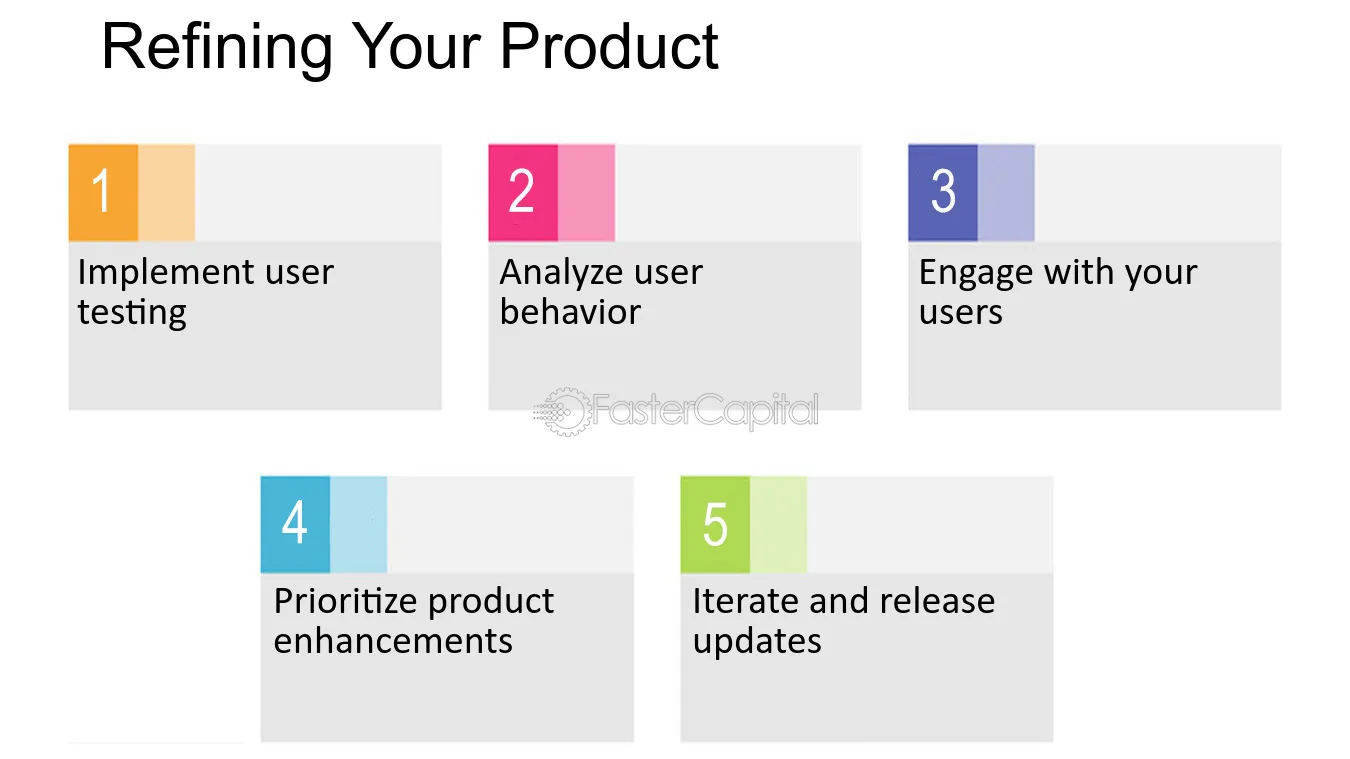Are you an entrepreneur seeking to refine your startup concept? Look no further, as you’ve come to the right place to discover the art of obtaining valuable feedback for your venture. Get ready to embark on a fascinating journey with actionable insights designed specifically for you!
Seeking feedback: The art of refining your startup concept involves defining and effectively communicating your value proposition, conducting customer discovery, building a minimum viable product (MVP) for testing market assumptions, and learning from customer interactions to tailor the product to their needs. Familiarize yourself with the different approaches to incorporating customer feedback for refinement and iteration, such as establishing feedback loops for continuous product improvement, prioritizing changes based on impact, testing changes with focused user groups and analyzing results, and utilizing advanced analytical tools for deeper insights.
So, what are you waiting for? Dive into this insightful resource, tailored to empower you with all you need to know about transforming your startup into a success story. Let’s level up, shall we?
Defining and Communicating Your Startup’s Value Proposition
Understanding and articulating the unique benefits of your product or service
As an entrepreneur, recognizing and focusing on the core advantages your startup offers will set you apart from your competitors. Your value proposition should address customer needs and provide solutions that are distinct and superior to what others in the market provide. Here are some strategies to keep in mind while identifying these advantages:
- Analyze your product or service’s unique selling points. What truly differentiates it from competitors?
- Understand your target market and their preferences. Who will benefit most from your product or service?
- Consider the most compelling reasons why potential customers should choose your startup over competitors.
Once you have identified the unique benefits of your product or service, it’s essential to communicate your value proposition clearly to potential customers and stakeholders. Here are some tips to effectively convey your message:
- Keep your message simple, concise, and easily digestible for your target audience.
- Incorporate the value proposition into all marketing materials, including your website, social media platforms, and promotional content.
- Utilize visual aids, like infographics or videos, to convey your message in an engaging manner.
Conducting customer discovery to validate your value proposition
Before diving headfirst into product development, your startup must undertake customer discovery to validate the value proposition you plan to offer. According to FasterCapital, this involves identifying your target audience’s pain points, assessing market demand, and tailoring your product idea accordingly.
Conduct substantial market research by gathering data and insights from prospective customers, industry experts, and direct competitors. This will help you validate if your value proposition is truly as unique and desirable as you initially envisioned.
Building a minimum viable product (MVP) to test market assumptions
Developing an MVP involves creating a product with minimal, yet essential, features that showcase the startup’s core value proposition. This should solve customer problems in the most efficient way possible, while using the fewest resources.
Follow these guidelines for creating a high-quality MVP:
- Determine the key benefits you want your MVP to provide.
- Prioritize features based on their necessity for effectively solving your target audience’s main problems.
- Set clear objectives for your MVP to help guide future development and decision-making.
It’s important to remember that MVP development is an iterative process, meaning that continual improvement based on customer feedback is essential. This enables your startup to analyze existing functionality and refine its offerings to better meet customer needs.
Measuring and learning from customer interactions with your product
To further enhance your startup concept, it’s crucial to track user engagement and gather insights. This knowledge can be used to update and improve your product to better suit user needs and desires. Strategies to use at this stage include:
- Interpreting user behavior by observing how customers interact with your product or service.
- Gathering qualitative feedback from customers through surveys, interviews, or focus groups.
- Analyzing user metrics, such as acquisition, retention, engagement, and conversion rates, to evaluate the success of your value proposition.
By employing these approaches, your startup can glean valuable information from customer interactions, fostering continuous refinement and improvement.

Source: FasterCapital
To summarize, refining your startup concept begins with clearly understanding and communicating the value proposition you offer. Validate your value proposition through customer discovery, and then create an MVP to test market assumptions. Finally, learn from customer interactions, gathering insights from user engagement metrics and direct feedback to optimize your product and enhance its overall market fit. By following this process diligently, you will be better equipped to adapt to changing customer needs and preferences, ultimately ensuring the growth and success of your startup.
Establishing Feedback Loops for Continuous Product Improvement
One of the essential aspects of refining your startup concept is incorporating customer feedback into your product development process. By establishing a “feedback loop“, you ensure that the insights and opinions of your users are taken into account, enabling you to modify and improve your product continually. According to Startup Magazine, breaking down work into smaller increments allows you to deliver value to customers more frequently and respond to their feedback and changing needs in a timely manner.
To establish a feedback loop, some best practices include:
- Regularly testing your product with customers
- Actively seeking customer opinions through surveys and interviews
- Using analytics tools to track user behavior and identify issues
- Iterating on your product based on collected feedback
Prioritizing Changes Based on Customer Feedback Impact
Once you’ve gathered user feedback, the next step is to prioritize the changes you want to make to your product. The best way to do this is to evaluate the potential impact of each change on the customer experience and product-market fit.
To prioritize effectively, consider the following factors:
- Severity: How important is the issue for your users? A critical bug or usability problem should be addressed immediately.
- Frequency: How often does the problem occur? High-frequency issues should be prioritized over occasional or rare problems.
- Effort: What resources are required to make the change? Consider the impact on development time and cost – prioritize low-effort changes with high benefits.
- Alignment: Does the change align with your product vision and company goals? Prioritize changes that help you achieve your business objectives.
Remember that not all feedback will be actionable or relevant to your overall vision. Filtering through the noise is essential for maintaining focus and ensuring your product remains true to its purpose.
Testing Changes With a Focused User Group and Analyzing Results
Before rolling out any significant modifications to your product, it’s crucial to test and validate these changes with a focused user group. This process allows you to observe how the alterations affect user behavior and ensure that they contribute positively to the product experience. As pointed out by AIContentfy, by analyzing these interactions, you can identify recurring problems users encounter and enhance your product idea further.
Some steps to conduct focused user testing include:
- Selecting a diverse group of users that accurately represents your target audience
- Providing clear instructions on how to use the updated product version and the changes made
- Observing user behavior and interactions with the new features or adjustments
- Collecting and analyzing feedback on the update, including the perceived value and possible room for improvement
Utilizing Advanced Analytical Tools for Deeper Insights
Supplementing customer feedback with advanced analytical tools ensures a more comprehensive understanding of user behavior and preferences. These platforms can provide deeper insights into customer interaction data, shedding light on areas where your product may need improvement and helping you identify opportunities to delight users further. Some popular analytics tools include Google Analytics, Mixpanel, and Amplitude.
By leveraging advanced analytics, you can:
- Track user engagement with various product features
- Identify patterns in user behavior and preferences
- Segment users based on their behavior and characteristics
- Optimize the onboarding process to improve user acquisition and retention rates
- Discover potential areas for product expansion or new feature development
With this data in hand, you can make more informed decisions on where to focus your resources and effort, ensuring your startup maintains a competitive edge.
Conclusion
The road to refining your startup concept is a continuous process of iteration and improvement. By seeking feedback from your users, prioritizing changes, testing with a focused user group, and utilizing advanced analytical tools, you can ensure your product remains dynamic, responsive, and relevant to your target audience. Embrace this approach and watch your startup grow and flourish in the competitive landscape of 2024.
Frequently Asked Questions
How do I establish a feedback loop with my customers?
To establish a feedback loop, regularly test your product with customers, actively seek customer opinions through surveys and interviews, use analytics tools to track user behavior and identify issues, and iterate on your product based on collected feedback.
How do I prioritize changes based on customer feedback impact?
Evaluate the potential impact of each change on the customer experience and product-market fit, considering factors such as severity, frequency, effort, and alignment with your product vision and company goals.
How can I conduct focused user testing?
Select a diverse group of users that accurately represents your target audience, provide clear instructions on how to use the updated product version and the changes made, observe user behavior and interactions with the new features or adjustments, and collect and analyze feedback on the update.
What are some popular advanced analytical tools for startups?
Some popular analytics tools for startups include Google Analytics, Mixpanel, and Amplitude. These platforms can provide deeper insights into customer interaction data, shedding light on areas where your product may need improvement and identifying opportunities to delight users further.
Why is it important to use advanced analytics in addition to customer feedback?
Advanced analytics can supplement customer feedback by providing deeper insights into user behavior and preferences. This data helps you make more informed decisions on where to focus your resources and effort, ensuring your startup maintains a competitive edge.






